| CHRYSLER 300 History
Introduction: Some
MOPAR purists insist that the Chrylser 300 Series or "Letter Cars" were
the first muscle cars. That is debatable as the 300 Series were fast, large,
luxury coupes instead of cheap all out intermediate size performance. However,
there is no denying that the elegant if somewhat unconventionally styled
Chrysler 300 Series made performance cool again and started the horsepower
race among American automobile manufacturers. And for that, all muscle
car fans must be thankful.
1955 Chrysler
C-300
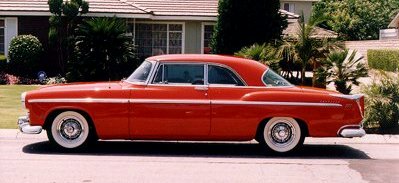 Comments:
The Chrysler 300 "Letter Car" debuted in 1955 and firmly established Chrysler
as the king of performance. Positioned as an expensive and fast luxury
coupe, the C-300 ("C" stood for coupe, "300" stood for the 300 bhp engine)
was only available as a hardtop coupe and came only in three colors: black,
red, and white. Standard power was MOPAR's top engine, a 331 cid Hemi V8
with two four barrel carbs, a full-race cam, solid lifters, special manifolds,
fat dual exhausts, and 300 bhp. The Hemi engine derived its name from its
hemispherical combustion chambers. These chambers required a pair of rocker
arm shafts on each cylinder head, with the spark plugs fitting between
the valves. Comments:
The Chrysler 300 "Letter Car" debuted in 1955 and firmly established Chrysler
as the king of performance. Positioned as an expensive and fast luxury
coupe, the C-300 ("C" stood for coupe, "300" stood for the 300 bhp engine)
was only available as a hardtop coupe and came only in three colors: black,
red, and white. Standard power was MOPAR's top engine, a 331 cid Hemi V8
with two four barrel carbs, a full-race cam, solid lifters, special manifolds,
fat dual exhausts, and 300 bhp. The Hemi engine derived its name from its
hemispherical combustion chambers. These chambers required a pair of rocker
arm shafts on each cylinder head, with the spark plugs fitting between
the valves.
The C-300 also featured
a performance modified PowerFlite automatic transmission and special Blue
Streak racing tires. To further enhance its high speed image, the C-300
came without an outside rearview mirror. The C-300 quickly became a legend
when it did 127.58 mph in the Flying Mile and averaged 92 mph in the Daytona
Grand National stock race. Priced from ,055 with a leather interior standard,
the C-300 represented the top of the line Chrysler and only 1,725 were
built. Only an exstimated 8% of those survive today.
Production: 1,725
Engines: 331 V8 Hemi
300bhp.
1956 Chrysler
300 B
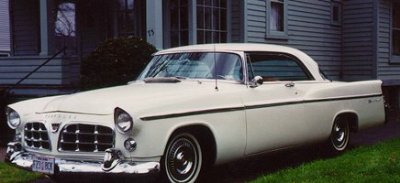 Comments:
In 1956, the 300B was released and all future models would be labeled with
a sequential letter after the 300. The new standard engine was upgraded
to a new 354 cid Hemi V8 with similar features which generated 340 bhp.
Optional was a more powerful version with 10:1 compression that produced
355 bhp. Standard with the optional motor was a special three inch exhaust
system. Performance of the new 300B improved as it averaged over 90 mph
in the Daytona Grand National and hit almost 140 mph in the Flying Mile.
Only 1,102 copies were sold. Comments:
In 1956, the 300B was released and all future models would be labeled with
a sequential letter after the 300. The new standard engine was upgraded
to a new 354 cid Hemi V8 with similar features which generated 340 bhp.
Optional was a more powerful version with 10:1 compression that produced
355 bhp. Standard with the optional motor was a special three inch exhaust
system. Performance of the new 300B improved as it averaged over 90 mph
in the Daytona Grand National and hit almost 140 mph in the Flying Mile.
Only 1,102 copies were sold.
Production: 1,102
Engines: 354 V8 Hemi
340 bhp. 354 V8 Hemi 355 bhp.
1957 Chrysler
300 C
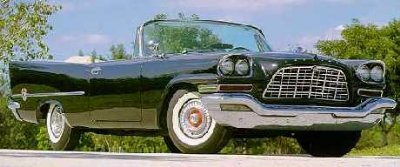 Comments:
For 1957, the 300C featured a new 392 cid Hemi V8 with 375 bhp standard.
Optional was a high performance version with a more radical cam, 10.1:1
compression (instead of 9.25:1) fatter exhausts and a manual transmission
which were good for 390 bhp. Only 18 of these were built. Also available
for the first time was a convertible model. The 300 played on the American
theme with ten red, white, and blue "300" medallions and the wheelcovers
had a red finish painted in the depressed outer layers of the covers. Comments:
For 1957, the 300C featured a new 392 cid Hemi V8 with 375 bhp standard.
Optional was a high performance version with a more radical cam, 10.1:1
compression (instead of 9.25:1) fatter exhausts and a manual transmission
which were good for 390 bhp. Only 18 of these were built. Also available
for the first time was a convertible model. The 300 played on the American
theme with ten red, white, and blue "300" medallions and the wheelcovers
had a red finish painted in the depressed outer layers of the covers.
Production: Coupes:
1,767, Convertibles: 484
Engines: 392 V8 Hemi
375 bhp. 392 V8 Hemi 390 bhp.
Performance: 392/375:
0-60 in 7.7 seconds, 1/4 mile in 17 seconds at 84 mph.
1958 Chrysler
300 D

Comments: The standard
engine in the 1958 300D was again upgraded. The 392 Hemi V8 featured 10.0:1
compression, new valve timing, heavier pistons, and a new camshaft, which
resulted in 380 bhp. A very rare option was a 390 bhp Hemi with electronic
fuel-injection. This 0 EFI system proved trouble-prone and most of the
35 fuel-injected cars were recalled to install the standard dual carburetors.
Exterior changes were minimal with a simpler eggcrate grille up front and
odd, truncated taillights that no longer filled the space for them in the
tail fins featured on the rear. The 300D was a large car with two-door
hardtops weighing in at 4,305 pounds and covertibles grossing 4.475 pounds.
Perhaps as a result of this heft, power brakes came standard. Performance
was still world class, when a 300D driven by Norm Thatcher at Utah's Bonneville
Salt Flats to a new Class E speed record of 156.387 mph. And Brewster Shaw
drove one at the Daytona beaches, producing a quarter-mile time of 16 seconds
with a trap speed of 94 mph. Despite this performance, only 618 hardtops
and 191 convertibles were produced. This would be the last year for the
Chrysler Hemi engine -- at least for now.
Production: Coupes:
618, Convertibles: 191
Engines: 392 V8 Hemi
380 bhp @ 3800 rpm, 435 lb-ft @ 3600 rpm. 392 V8 Hemi (EFI) 390 bhp.
Performance: 392/375:
0-60 in 7.7 seconds, 1/4 mile in 17 seconds at 84 mph.
1959 Chrysler
300 E
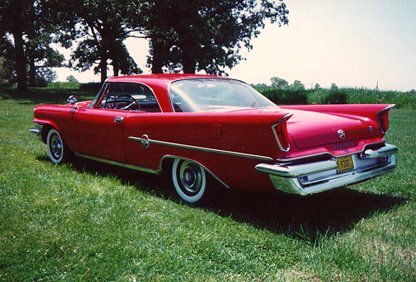 Comments:
The big news for 1959 was the new Golden Lion V8 which replaced the heavy
and expensive Hemi V8. The new Golden Lion V8 sported Chrysler's new wedge-shaped
combustion chamber design. Displacement increased to 413 cid but the engine
actually weighed 103 pounds less than the 392 cid Hemi V8 it replaced.
Much of this weight reduction was due to the use of a single rocker shaft
and the lighter and more compact cylinder head. A smaller 16 quart (instead
of the previous 25 quart) cooling system also saved 18 pounds. The new
413 "Wedge" V8 continued to use dual four barrel carburetors and the compression
ratio was slightly higher (10.1:1) than the previous Hemi (10.0:1). The
413 Wedge also featured low-restriction air cleaners, heavy-duty valve
springs and dampers, and a fluid fan drive. The 300 E continued to use
Chrysler's three-speed TorqueFlite as its standard transmission. Acceleration
was fast at a claimed 8.3 second 0-60 time. The 300 E suspension continued
to use front torsion bars and semi-elliptic rear leaf springs. New for
1959 were the 300 E's special Goodyear Blue Streak 9.00x14.00 tires. These
tires were constructed of nylon, had a low cord angle, and a unique tread
design. The 300 E's standard power steering, with 3.5 turns lock-to- lock
provided sports car response. Comments:
The big news for 1959 was the new Golden Lion V8 which replaced the heavy
and expensive Hemi V8. The new Golden Lion V8 sported Chrysler's new wedge-shaped
combustion chamber design. Displacement increased to 413 cid but the engine
actually weighed 103 pounds less than the 392 cid Hemi V8 it replaced.
Much of this weight reduction was due to the use of a single rocker shaft
and the lighter and more compact cylinder head. A smaller 16 quart (instead
of the previous 25 quart) cooling system also saved 18 pounds. The new
413 "Wedge" V8 continued to use dual four barrel carburetors and the compression
ratio was slightly higher (10.1:1) than the previous Hemi (10.0:1). The
413 Wedge also featured low-restriction air cleaners, heavy-duty valve
springs and dampers, and a fluid fan drive. The 300 E continued to use
Chrysler's three-speed TorqueFlite as its standard transmission. Acceleration
was fast at a claimed 8.3 second 0-60 time. The 300 E suspension continued
to use front torsion bars and semi-elliptic rear leaf springs. New for
1959 were the 300 E's special Goodyear Blue Streak 9.00x14.00 tires. These
tires were constructed of nylon, had a low cord angle, and a unique tread
design. The 300 E's standard power steering, with 3.5 turns lock-to- lock
provided sports car response.
The appearance of the 300
E was similar to the previous model. The most significant change was the
use of narrow horizontal red bars highlighted by four chrome bars in place
of the older eggcrate grille. Red bars were also used in the narrow air
scoops for the front brakes that were positioned below the headlights.
Also new were the "300" letters located on the lower, driver side portion
of the hood. At the rear were new taillights and a larger bumper with recessed
back-up lights. The 300 medallion was positioned near the front of the
side sweep spear. Also new were wheelcovers with gear-shaped center portions.
Inside, the instrumental continued the tradition of easy-to- read gauges
with two large circular gauges. The left unit contained the odometer and
the 150 mph speedometer. The right unit contained the ammeter, fuel, oil
pressure, and water temperature gauges. The 300 E also sported a unique
standard front swivel seats finished in a new natural tan "Living Leather"
upholstery that used a basket-weave pattern. Its perforations were intended
to allow air circulation in warm weather. The swivel seats were controlled
by a lever located at the base of the seat and could swivel through a 60
degree angle to facilitate entry and exit into the vehicle. The 300 E was
available as either a two dour hardtop coupe for ,319, or a convertible
for ,749. Both came in six different colors: ivory white, formal black,
cameo tan, metallic turquoise-grey, radiant red, or copper spice. The loss
of the Hemi engine took its toll on sales, however, as only 522 coupes
and a mere 125 convertibles were sold.
Production: Coupes:
522, Convertibles: 125
Engines: 413 V8 Wedge
380 bhp @ 3800 rpm, 450 lb-ft @ 3600 rpm.
Performance: 413/380:
0-60 in 8.3 seconds.
1960 Chrysler
300 F
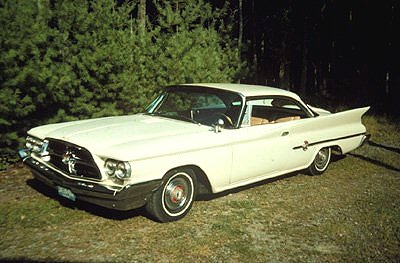 Comments:
To fill the vacuum caused the loss of the Hemi, Chrysler introduced a new
ram-inducted 413 cid Wedge V8 good for 375 bhp in standard form and a whooping
400 bhp in optional form. Engine hardware common to both included a hot
cam, heavy-duty valve springs, low back-pressure exhaust system, dual point
distributor, low- restriction air cleaner, special plugs and dual four
barrel carbs. The carbs were mounted on a wild looking cross-ram manifold
that put one air cleaner on each side of the engine. The stacks were 30
inches long and had to be criss-crossed to fit under the hood. These long
rams were designed to produce a supercharging effect in the heart of the
rpm range. At low speeds, the "long" rams worked great, but they hurt performance
above 4,000 rpm. To solve that problem, Chrysler's engineers removed a
section of the inner walls of the manifolds to create the optional 400
bhp engine. On the outside, these "short" rams looked the same, but they
were effectively only 15 inches long. Only 15 of these "short" ram cars
were built, mainly for Daytona or Flying Mile race cars. The 0 "short"
ram option also included a rare four-speed Pont-a-Mousson manual transmission,
a French made trasmission made for the Facel Vega, a Chrysler powered French
luxury car. One of the 400 bhp cars set a Flying Mile record of 144.9 mph.
The 1960 300 F also was the first year to use Chrysler's weight saving
uni-body construction, which further helped performance. Sales increased
to 969 hardtop coupes and 248 convertibles. Comments:
To fill the vacuum caused the loss of the Hemi, Chrysler introduced a new
ram-inducted 413 cid Wedge V8 good for 375 bhp in standard form and a whooping
400 bhp in optional form. Engine hardware common to both included a hot
cam, heavy-duty valve springs, low back-pressure exhaust system, dual point
distributor, low- restriction air cleaner, special plugs and dual four
barrel carbs. The carbs were mounted on a wild looking cross-ram manifold
that put one air cleaner on each side of the engine. The stacks were 30
inches long and had to be criss-crossed to fit under the hood. These long
rams were designed to produce a supercharging effect in the heart of the
rpm range. At low speeds, the "long" rams worked great, but they hurt performance
above 4,000 rpm. To solve that problem, Chrysler's engineers removed a
section of the inner walls of the manifolds to create the optional 400
bhp engine. On the outside, these "short" rams looked the same, but they
were effectively only 15 inches long. Only 15 of these "short" ram cars
were built, mainly for Daytona or Flying Mile race cars. The 0 "short"
ram option also included a rare four-speed Pont-a-Mousson manual transmission,
a French made trasmission made for the Facel Vega, a Chrysler powered French
luxury car. One of the 400 bhp cars set a Flying Mile record of 144.9 mph.
The 1960 300 F also was the first year to use Chrysler's weight saving
uni-body construction, which further helped performance. Sales increased
to 969 hardtop coupes and 248 convertibles.
Production: Coupes:
969, Convertibles: 248
Engines: 413 V8 Wedge
"long" ram 375 bhp @ 5000 rpm, 495 lb-ft @ 2800 rpm. 413 V8 Wedge "short"
ram 400 bhp @ 5000 rpm, 465 lb-ft @ 3600 rpm.
Performance: 413/375:
0-60 in 7.0 seconds, 1/4 mile in 16.00 seconds @ 85.0 mph.
1961 Chrysler
300 G
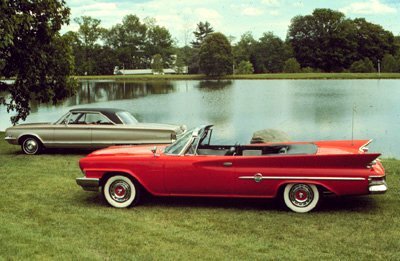 Comments:
The 1961 Chrysler 300 G saw a major exterior redesign that sported an inverted
grille shape, redesigned headlights, and the relocation of the taillights
from the fins to above the rear bumper. Other changes included reshaping
the canted tail fins and replacing the (optional) Imperial-like trunk lid
with a ribbed unit. Interior revisions included a speedometer that read
from 0-150 mph in single mph units, a black finish for all painted sections
of the dash, and changes in the design of the dash panel padding and seat
preforation. Four exterior colors were offered: Formal Black, Alaskan White,
Mardi Gras Green, and Cinnamon. Among the 300 G's equipment features were
chrome wheelcovers, a "SilentFlite" fan drive, front and rear armrests,
windshield washers and an electronic clock. Numerous options were available
including air conditioning, remote-control exterior mirrors, six-way power
seat, power door locks, and a "Sure-Grip" differential. Under the hood,
the two Wedge V8s with "long" and "short" ram tubes carried over, but a
standard axle ratio of 3.23:1 gave the 300 G a slight top speed advantage
over the 300 F. On the optional 400 bhp version, a Chrysler heavy-duty
three speed manual transmission replaced the expensive French four speed.
Other performance highlights included suspension front torsion bars that
were 33% stiffer than standard, 60 inch leaf springs that were 9% stiffer
than standard, and 8.00x15 Goodyear Blue Streak Super Sport high performance
white wall tires. Comments:
The 1961 Chrysler 300 G saw a major exterior redesign that sported an inverted
grille shape, redesigned headlights, and the relocation of the taillights
from the fins to above the rear bumper. Other changes included reshaping
the canted tail fins and replacing the (optional) Imperial-like trunk lid
with a ribbed unit. Interior revisions included a speedometer that read
from 0-150 mph in single mph units, a black finish for all painted sections
of the dash, and changes in the design of the dash panel padding and seat
preforation. Four exterior colors were offered: Formal Black, Alaskan White,
Mardi Gras Green, and Cinnamon. Among the 300 G's equipment features were
chrome wheelcovers, a "SilentFlite" fan drive, front and rear armrests,
windshield washers and an electronic clock. Numerous options were available
including air conditioning, remote-control exterior mirrors, six-way power
seat, power door locks, and a "Sure-Grip" differential. Under the hood,
the two Wedge V8s with "long" and "short" ram tubes carried over, but a
standard axle ratio of 3.23:1 gave the 300 G a slight top speed advantage
over the 300 F. On the optional 400 bhp version, a Chrysler heavy-duty
three speed manual transmission replaced the expensive French four speed.
Other performance highlights included suspension front torsion bars that
were 33% stiffer than standard, 60 inch leaf springs that were 9% stiffer
than standard, and 8.00x15 Goodyear Blue Streak Super Sport high performance
white wall tires.
Production: Coupes:
1,280, Convertibles: 338
Engines: 413 V8 Wedge
"long" ram 375 bhp @ 5000 rpm, 495 lb-ft @ 2800 rpm. 413 V8 Wedge "short"
ram 400 bhp @ 5000 rpm, 465 lb-ft @ 3600 rpm.
Performance: 413/375:
0-60 in 7.0 seconds, 1/4 mile in 16.00 seconds @ 85.0 mph.
1962 Chrysler
300 H
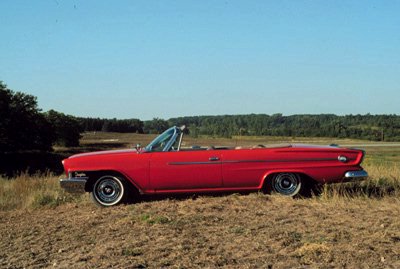 Comments:
1962 saw the beginning of the end to the exclusive 300 "letter cars." Chrysler
debuted a new line of non-letter Sport 300s which used a milder 383 cid
two-barrel carb V8 engine standard and shared their 122 inch wheel base
with Chrysler's low-priced Newport line. A real letter car, the 300 H,
was still offered but it too was based on the same smaller platform to
hold down production costs. The shorter wheelbase actually shaved 300 pounds
and therefore increased performance. Curb weight fell to 4.050 lbs for
the hardtop and 4,105 pounds for the convertible. Both 413 cid V8s were
boosted by 5 bhp, to 380 bhp and 405 bhp respectively. The lighter weight
and higher horsepower resulted in the best power to weight ratio (10.6
lbs per horsepower) of any 300 Letter car. Its 0-60 time of 7.7 seconds
matched the 1957 Hemi powered 300 C while its quarter-mile time of 16 seconds
matched the Ram Tuned 300 F. Meanwhile, the 300 H continued to offer an
interior with four bucket seats done in tan leather (other colors of leather
were available as special order). Although an outstanding performer, the
300 H lacked the exclusivity of previous 300 Letter cars. Its smaller size
and similar body style to the cheaper Sport 300 as well as the availability
of most 300 H features as optional equipment on the Sport 300 hurt sales.
To add insult to injury, its trademark tailfins were shaved off, the result
of a management shake-up that wanted to remove away from the design influences
of stylist Virgil Exner, a big fan of fins. The base prices of the 300
H also hurt sales, with the hardtop coupe at a lofty ,090 and the convertible
a whooping ,461. All these factors combined to make 1962 the worst selling
year for the 300 Letter cars with only 435 coupes and a mere 135 convertibles
sold. Comments:
1962 saw the beginning of the end to the exclusive 300 "letter cars." Chrysler
debuted a new line of non-letter Sport 300s which used a milder 383 cid
two-barrel carb V8 engine standard and shared their 122 inch wheel base
with Chrysler's low-priced Newport line. A real letter car, the 300 H,
was still offered but it too was based on the same smaller platform to
hold down production costs. The shorter wheelbase actually shaved 300 pounds
and therefore increased performance. Curb weight fell to 4.050 lbs for
the hardtop and 4,105 pounds for the convertible. Both 413 cid V8s were
boosted by 5 bhp, to 380 bhp and 405 bhp respectively. The lighter weight
and higher horsepower resulted in the best power to weight ratio (10.6
lbs per horsepower) of any 300 Letter car. Its 0-60 time of 7.7 seconds
matched the 1957 Hemi powered 300 C while its quarter-mile time of 16 seconds
matched the Ram Tuned 300 F. Meanwhile, the 300 H continued to offer an
interior with four bucket seats done in tan leather (other colors of leather
were available as special order). Although an outstanding performer, the
300 H lacked the exclusivity of previous 300 Letter cars. Its smaller size
and similar body style to the cheaper Sport 300 as well as the availability
of most 300 H features as optional equipment on the Sport 300 hurt sales.
To add insult to injury, its trademark tailfins were shaved off, the result
of a management shake-up that wanted to remove away from the design influences
of stylist Virgil Exner, a big fan of fins. The base prices of the 300
H also hurt sales, with the hardtop coupe at a lofty ,090 and the convertible
a whooping ,461. All these factors combined to make 1962 the worst selling
year for the 300 Letter cars with only 435 coupes and a mere 135 convertibles
sold.
Production: Coupes:
435, Convertibles: 135
Engines: 413 V8 Wedge
"long" ram 380 bhp. 413 V8 Wedge "short" ram 405 bhp.
Performance: 413/380:
0-60 in 7.7 seconds, 1/4 mile in 16.00 seconds @ 85.0 mph.
1963 Chrysler
300 J
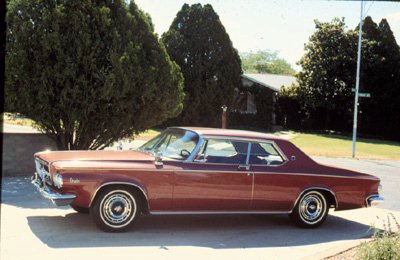 Comments:
Chrysler simplified its lineup for the new 300 J (there was no 300 I -
perhaps they felt the "I" would be confused with "1"). The convertible
version was dropped, as well as the "short" ram Wedge V8. The only engine
offered was the 413 cid Wedge head V8 with "long" rams which was now rated
at 390 bhp. The 300 J was available in five colors: Formal Black, Alabaster,
Madison Grey, Oyster White, and Claret. Two pinstripes (in a contrasting
color) ran the length of the body and 300 J medallions were placed on the
C-pillar and the rear deck. The interior featured a controversial square
steering wheel that many drivers found uncomfortable, but the excellent
design of the front seats (finished in claret red leather) as well as quality
interior appointments made up some of that. The exterior even featured
unique windshield wiper blades with airfoils designed to press the blade
against the windshield at high speeds, important because the 300 J could
reach 142 mph. Comments:
Chrysler simplified its lineup for the new 300 J (there was no 300 I -
perhaps they felt the "I" would be confused with "1"). The convertible
version was dropped, as well as the "short" ram Wedge V8. The only engine
offered was the 413 cid Wedge head V8 with "long" rams which was now rated
at 390 bhp. The 300 J was available in five colors: Formal Black, Alabaster,
Madison Grey, Oyster White, and Claret. Two pinstripes (in a contrasting
color) ran the length of the body and 300 J medallions were placed on the
C-pillar and the rear deck. The interior featured a controversial square
steering wheel that many drivers found uncomfortable, but the excellent
design of the front seats (finished in claret red leather) as well as quality
interior appointments made up some of that. The exterior even featured
unique windshield wiper blades with airfoils designed to press the blade
against the windshield at high speeds, important because the 300 J could
reach 142 mph.
Production: Coupes:
400
Engines: 413 V8 Wedge
"long" ram 390 bhp @ 4800 rpm, 485 lb-ft @ 3600 rpm.
Performance: 413/390:
0-60 in 8.0 seconds, 1/4 mile in 15.8 seconds @ 89 mph.
1964 Chrysler
300 K
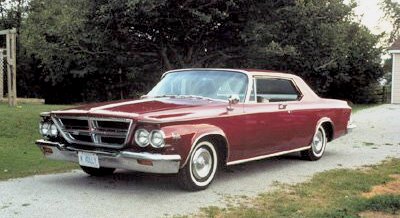 Comments:
Chrysler reacted to the minimal sales of the 300 J with changes that would
make the 1964 300 K the best selling 300 Letter car ever. The biggest news
was the return of the convertible version after a one year hiatus and the
introduction of a new base engine, a 413 cid V8 with 360 bhp. For an extra
5, a buyer could order the previous year's standard engine, a 413 V8
with 390 bhp. Leather trim was now a option. This decontenting resulted
in a massive price drop, from ,260 to ,056 for the two-door coupe and
a ,522 for the convertible. Both prices were about 0 more than the
lesser Sport 300 models which shared the same body and platform as the
300 K. Nevertheless, the price reduction resulted in record sales for the
300 J. Comments:
Chrysler reacted to the minimal sales of the 300 J with changes that would
make the 1964 300 K the best selling 300 Letter car ever. The biggest news
was the return of the convertible version after a one year hiatus and the
introduction of a new base engine, a 413 cid V8 with 360 bhp. For an extra
5, a buyer could order the previous year's standard engine, a 413 V8
with 390 bhp. Leather trim was now a option. This decontenting resulted
in a massive price drop, from ,260 to ,056 for the two-door coupe and
a ,522 for the convertible. Both prices were about 0 more than the
lesser Sport 300 models which shared the same body and platform as the
300 K. Nevertheless, the price reduction resulted in record sales for the
300 J.
Production: Coupes:
3,022, Convertibles: 625
Engines: 413 V8 Wedge
360 bhp. 413 V8 Wedge "long" ram 390 bhp @ 4800 rpm, 485 lb-ft @ 3600 rpm.
1965 Chrysler
300 L
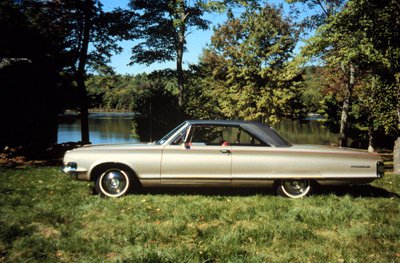 Comments:
The 1965 300 L represented the last of the Chrysler 300 Letter cars. Nearly
every feature of the 300 L either standard or optional on the non-letter
300s, there was little need to justify a seperate model line. Nevertheless,
the standard 413 cid V8 with 390 bhp in the 300 L resulted in good performance.
The only truly unique feature of the 300 L was a medallion at the center
of its silver crossbar grille which glowed softly at night when the headlights
were turned on. Despite its lack of uniqueness, the 300 L enjoyed the second
highest sales of any 300 Letter car. But this wasn't enough as Chrysler
decided to cancel plans for a 300 M (although they would use the name on
a completely different car almost 35 years later). The proud tradition
of the 300 Letter cars officially ended after 1965. Comments:
The 1965 300 L represented the last of the Chrysler 300 Letter cars. Nearly
every feature of the 300 L either standard or optional on the non-letter
300s, there was little need to justify a seperate model line. Nevertheless,
the standard 413 cid V8 with 390 bhp in the 300 L resulted in good performance.
The only truly unique feature of the 300 L was a medallion at the center
of its silver crossbar grille which glowed softly at night when the headlights
were turned on. Despite its lack of uniqueness, the 300 L enjoyed the second
highest sales of any 300 Letter car. But this wasn't enough as Chrysler
decided to cancel plans for a 300 M (although they would use the name on
a completely different car almost 35 years later). The proud tradition
of the 300 Letter cars officially ended after 1965.
Production: Coupes:
2,405, Convertibles: 440
Engines: 413 V8 Wedge
"long" ram 390 bhp @ 4800 rpm, 485 lb-ft @ 3600 rpm.
CHRYSLER 300 M
1999
It has been more than 30 years since
Chrysler built a 300 "letter series" car, leaving 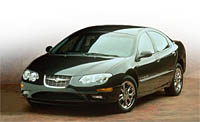 off
with the 300L in 1965. Chrysler picks up where it left off with the all-new
300M sports sedan. And while all previous "letter series" models were powered
by large V8s, the 300M gets a high-output V6 as its power plant. The 300M
shares a platform with its luxury sibling, the LHS; however, it is shorter
and sports different sheet metal. While the majority of 300Ms will be sold
in the U.S., it was designed with international markets in mind as well,
and is expected to become the image leader for the Chrysler brand overseas.
The 300M will begin arriving in U.S. showrooms this summer. off
with the 300L in 1965. Chrysler picks up where it left off with the all-new
300M sports sedan. And while all previous "letter series" models were powered
by large V8s, the 300M gets a high-output V6 as its power plant. The 300M
shares a platform with its luxury sibling, the LHS; however, it is shorter
and sports different sheet metal. While the majority of 300Ms will be sold
in the U.S., it was designed with international markets in mind as well,
and is expected to become the image leader for the Chrysler brand overseas.
The 300M will begin arriving in U.S. showrooms this summer.
The 1999 Chrysler 300M is available
in a single trim. Safety features include dual airbags, an anti-lock brake
system (ABS), traction control and child safety locks. A high-output 3.5-liter
253 horsepower V6 engine teamed with Chrysler's 4-speed AutoStick transmission
powers the 300M. Standard equipment includes automatic climate control,
security alarm, power windows and door locks, keyless entry, leather and
wood trim, and an AM/FM stereo system with cassette and CD player. The
300M is also available with a Performance Handling package, which features
a performance suspension, stronger brakes, speed-rated tires, and removes
the governor that limits the speed to 118 mph. |